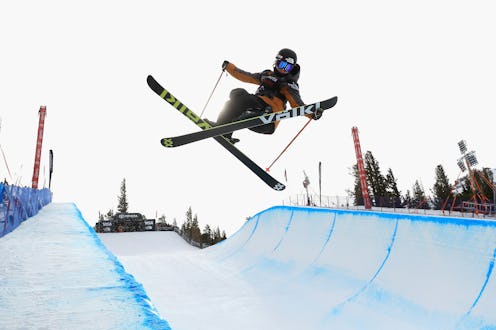News
This Is Exactly How Terrifyingly Tall The Halfpipe Is

There has only ever been one Olympic gold medal winner in women’s halfpipe skiing. The sport debuted at the Olympics in the 2014 Sochi Games, and is quickly becoming one of the most watched — especially after Maddie Bowman, an American, won the gold that year. Given its recent debut, though, there are lots of uncertainties about the rules of the halfpipe or even the halfpipe's dimensions: its length, height, and width.
As Bowman hits the halfpipe again in South Korea for the qualification round, make sure you have the rules of the game down to fully appreciate the difficult and new Olympic event.
First off, the halfpipe is not just the name of the event but also the course that the event is played on. Just like in skateboarding, snowboarding, or BMX, the ski halfpipe is a U-shaped ramp designed specifically for the sport. It allows the athletes in all these sports to go back and forth on the ramp, propelling themselves up into the air to perform tricks and moves.
The dimensions of the halfpipe are regulated at the Olympics. According to the 2018 PyeongChang Games' official website, the dimensions are "a slope length of minimum 150 and recommended 170m, a halfpipe width of 19 to 22m, and a height of 6.7m." The "average inclination" is also relegated to 17 or 18 degrees.
(For Americans, this means that the slope length is a minimum of approximately 490 feet, with a recommended approximately 550 feet. The width is 62 to 72 feet, and its height is about 22 feet.)
As the Olympic site explains, the skiers "glide down a halfpipe slope performing aerial skills such as jumps and turns." They are then judged based on the quality of their jumps and turns. Out of 100, the athletes are evaluated on the "height, turn, technique, and difficulty" of the turns. They get two runs down the course, and the highest average score (there are five judges) decides their ranking.
Bowman is the halfpipe skier to beat. Originally from South Lake Tahoe, California, she won the only gold in history. And at the age of 24, she should be in great shape to keep competing for years to come.
At the last game, Bowman wasn't the only U.S. skier or snowboarder to do well in the event. And they hope to keep the momentum going this year. "Team USA is capable of attaining, even building upon, that level of success in PyeongChang," the teams site says.
Since Sochi, Bowman has kept up her momentum, winning several X Games gold medals. In 2015 she had a setback with a severe injury that kept her off the course for the rest of the season. But by 2016 she was back winning the gold at the X Games in Aspen (that was her fourth consecutive gold at the X Games).
She also has a sense of humor, too. She spoke with Teen Vogue before the games and included a handful of hilarious answers in their Q&A. Like her answer to what she always needs when competing. "My skis," she joked to Teen Vogue. "I'm just kidding. One thing I always have to have ... a snack. We're up there for a lot of time in the day and throw a Clif bar in your pocket and you're good to go."
From interviews, clearly a big part of her life is her athleticism — though she also excels in math and is studying biology at Westminster College in Salt Lake City.
But let her near a hill — or a halfpipe — and that's where she's the happiest. "I try to live a really active life and am easily bored when I have too much down time," Bowman told U.S. Ski & Snowboard. "If I'm not competing or training and I have an opportunity to ski, you can definitely find me on the hill.”